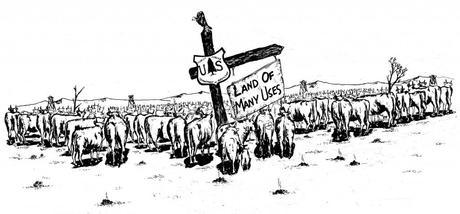
by Sandy / Earth First! Newswire
It may seem like small potatoes, but a mid-sized rancher is getting a militant hand from militia groups around the country who say that the Federal Gov is infringing on his right to put his cows out to pasture on public lands.
Cliven Bundy, the owner of the ranch, is having his cows rounded up by the Bureau of Land Management, because he continues to allow them to graze in lands that the feds describe as the arid, fragile ecosystem of the endangered desert tortoise.
So it goes that Cliven’s son, Ammon Bundy, was tazed by BLM police during a tense altercation, and nearly 200 cattle have been rounded up out of the 900 total. In response, militia groups from New Hampshire, Texas, and Florida are supposedly mobilizing to converge at the Bundy Ranch.
Two militia members have arrived thus far. “We need to be the barrier between the oppressed and the tyrants,” states one of the militia members, Ryan Payne of the West Mountain Rangers. “Expect to see a band of soldiers.”
Seizing a chance to jump on a podium, the governor of Nevada jumped into the fray, proclaiming, “No cow justifies the atmosphere of intimidation which currently exists nor the limitation of constitutional rights that are sacred to all Nevadans.” The governor also declared his disdain for the “Free Speech Area” into which protesters had been corralled.
Welfare Ranching and Power Struggle in the West
Cliven Bundy likes to mention that his family ranch has been around longer than the BLM. While his melon farm / ranch has been around since the 19th Century, the BLM was formed in 1946, having absorbed the US Grazing Service’s mission of stopping the overgrazing of the US West.
Bragging rights aside, the destruction of the West by cattle was rapid and drastic and there’s probably a good chance that Bundy’s ranch played a small part. In 1870, the cattle population in 17 western states numbered 4-5 million head; by 1890, 26.5 million.
Exposing the remarkable apathy with which the cattlemen consumed the land, in 1898 one Texas cattlemen’s association proclaimed, “Resolved, that none of us know, or care to know, anything about grasses, native or otherwise, outside the fact that for the present there are lots of them, the best on record, and we are after getting the most out of them while they last.”
By the 1940s, the West had become the desert that it is today. To stop the bleeding, the Feds tried to issue grazing permits allowing ranchers who followed their allotments of public lands for cut rate prices.
Due to economic problems with the US meat market and the destruction of the land, however, Federal grazing permits have become hard to come by. Only three percent of livestock producers in the US have permits (in the West, the number is 22 percent). Permit holders tend to be corporations like Del Webb or Hilton or rich people like Ted Turner. Some don’t even use their permits for grazing, but hold onto them to keep the value of their land up.
As SaveOurWildHorses explains, “Grazing Rights on our public lands today is not really about cows anymore,… it’s about holding title to a ‘vested interest’ in the land.”
Call It What It Is
The Feds own 80 percent of the land in Nevada, and the split between corporate ranching and small, family ranching has been the tinder for feuds in the past . Some observers have likened what is happening in Nevada today to the “Sagebrush Rebellion” of 1980.
The so-called “Sagebrush Rebellion” brought the “chamber of commerce, ranchers, and right wing fanatics” (to use the words of Dave Foreman) out in large numbers to revenge themselves upon what they deemed “the environmental elite.”
Supported by not a few corrupt politicians and business leaders, their struggle was ignited by a projected Wilderness Area in Moab, Utah. The event spread, demanding a transfer of public lands to the states (which would, supposedly, whither away into private hands). It was quite clearly one of the first of several noteworthy astroturfed occasions to come out of the contemporary political landscape (others being the Wise Use movement and the Tea Party).
The militia movement’s mobilization in Nevada today is important in that it does not attack the structures of welfare ranching, but instead insists on further private control over ranching to the detriment of public lands. This is why the US West needs a future of less ranching, more rewinding; restored native ecosystems, and more habitat for endangered species.
and now, here is Ammon Bundy getting tazed…
